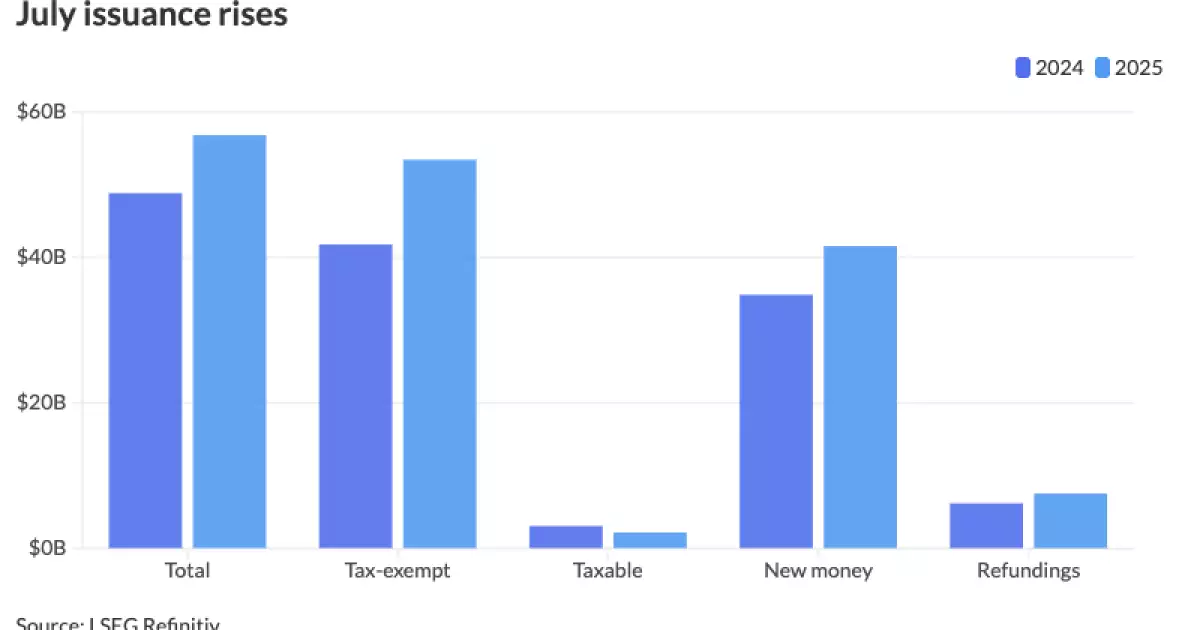Unearthing the Reality: Is the Record-Breaking Municipal Bond Surge a Misleading Mirage?

The recent surge in municipal bond issuance appears impressive at first glance, yet a closer, more critical look reveals underlying fragility. With issuance climbing to over $280 billion in the first half of the year—up by 14.3% compared to last year—the narrative suggests a booming, unstoppable market. But is this growth sustainable, or is it merely a reaction to fear, policy uncertainties, and strategic preemptive borrowing? It’s worth questioning whether this relentless supply genuinely signifies a healthy, forward-looking market or if it masks deeper vulnerabilities.
The fact that issuance sustained such momentum despite turbulent market conditions, tariff-induced volatility, and political headwinds should not lead us to complacency. Historically, municipal markets tend to slow during periods of uncertainty, yet this year has defied that norm, with issuers aggressively front-loading deals to hedge against potential policy setbacks. Are we witnessing a disciplined, strategic evolution? Or is this a panic-driven rush driven by uncertainty about future tax policies and political volatility?
Furthermore, while record issuance may seem like confidence in the sector, it could also be a sign of desperation. Borrowers taking on debt in fear of missing out on favorable terms or hoping to shield themselves from upcoming policy changes could ultimately be setting themselves up for future distress. Record-breaking issuance in a landscape rife with uncertain fiscal policies may be more indicative of a market trying to stabilize itself through sheer volume rather than genuine optimism.
Are We Overestimating Market Resilience or Validating Fears?
One of the more troubling aspects of this scenario is the sustained optimism that ignores looming policy threats. Reports show that some of the deal-making was driven by fears of the loss or reduction of tax exemptions. Politicians and policymakers have not definitively ruled out changes; some hints suggest targeted restrictions on private-activity bonds and certain issuers, such as hospitals and universities. Yet, the market has largely brushed aside these concerns, with issuance soaring regardless.
This disconnect between market behavior and political reality is critical. If the federal government or states begin trimming back on tax benefits—especially for high-profile sectors—there could be a sharp correction. Today’s aggressive issuance might appear smart and strategic, but it could turn into a risky gamble on future political stability and policy continuity. The assumption that exemptions will remain intact is a dangerous bet that could destabilize the municipal debt landscape if broken.
Moreover, the influx of larger, prestigious university deals suggests that sectors feeling the squeeze from federal budget cuts are pushing their financing needs earlier and more aggressively. This early borrowing may temporarily lift the sector, but in the longer term, it raises questions about sustainable fiscal strategies. Is the market merely relenting to a short-term funding crunch, or is it inadvertently setting itself up for a crisis when these borrowed funds are called upon in tougher fiscal times?
Valuations, Interest Rates, and the Illusion of Safety
Another critical aspect often overlooked is the environment of rising interest rates. Borrowers are now commanding higher yields, which temporarily boosts income for investors and creates a seemingly attractive environment. But this is a double-edged sword. Higher rates elevate borrowing costs and can reduce future fiscal flexibility for issuers, especially if economic conditions worsen or if rates continue upward.
The market’s perception of safety is further undermined when examining the types of deals that dominate this surge. Revenue bonds, general obligation bonds, and bank-qualified issues all carry different risk profiles, and while they currently appear resilient, their long-term sustainability hinges on economic stability. If the economy faces downturns or local tax bases shrink—especially in states experiencing economic disparities—the true risk exposure becomes more apparent.
The confidence driven by recent issuance numbers can foster complacency among investors and policymakers alike. A rising tide often masks underlying weaknesses—overleveraged entities, strained local economies, or overstretched credit profiles. The idea that current yields can reliably compensate for underlying risks assumes a stability that history has shown, perhaps erroneously, to be illusory.
The Political and Fiscal Elephant in the Room
Fiscal policy and political will are the real determinants of this market’s future, yet they are often overlooked amid short-term data excitement. The fear of losing tax advantages has prompted issuers to expedite deals, but whether this is a sustainable strategy remains questionable.
If policymakers in Washington or at the state level decide to scale back or eliminate key tax exemptions—a move highly contentious and politically charged—the market will face a sharp correction. The current enthusiasm, based on the assumption of policy stability, is not only shortsighted but dangerously optimistic. It’s akin to building a house on shifting sands, trusting that the underlying ground remains firm.
There’s also an ideological debate at play: the tension between fiscal conservatism and government expansion. While the market benefits from tax-exempt financing, persistent federal deficits and national debt concerns cast doubt on the capacity or willingness of future administrations to uphold these benefits. If public confidence wavers, and small policy adjustments snowball into larger tax reforms, the current issuance boom could quickly turn into a nightmare.
While the numbers suggest a thriving municipal bond arena, the underlying dynamics point to a different reality—one of opportunism, strategic borrowing, and looming risks. The market’s resilience is based more on hope and political rhetoric than on solid fiscal fundamentals. As investors and policymakers celebrate record volumes, they should do so with caution, recognizing that today’s strength might mask tomorrow’s instability. The true test will come not from how much is issued, but from whether that debt can sustain the long-term fiscal health of issuers in an uncertain economic and political landscape.





